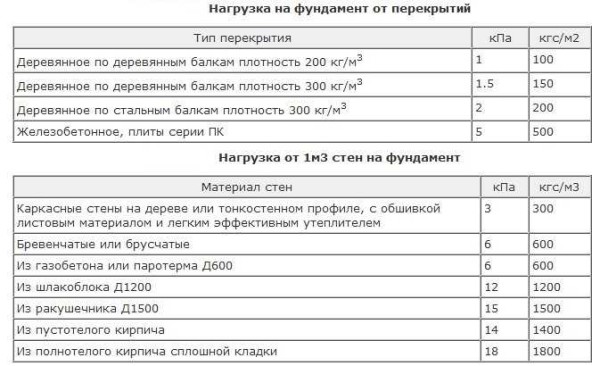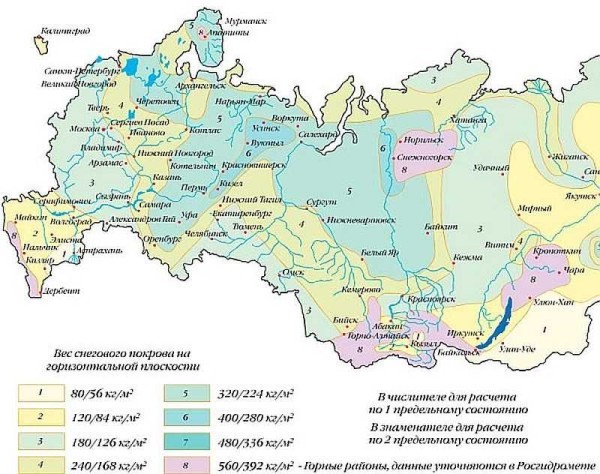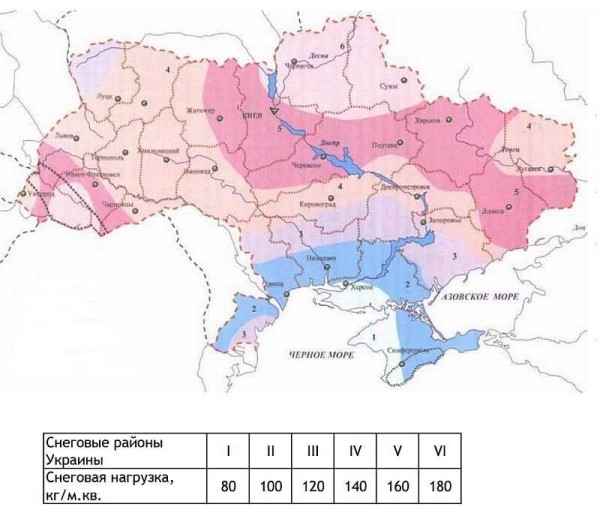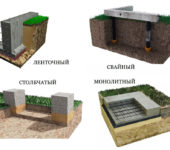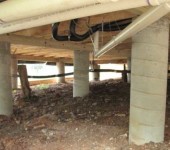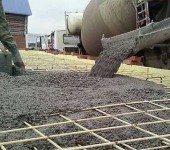Calculate the strip foundation with your own hands
Most popular in private construction strip foundations... They can be used for different houses on different types of soil, they can be calculated by hand. This does not require knowledge of higher mathematics or strength of materials. There is a method in which everything is simple, however, cumbersome: you have to collect a lot of data. This calculation of the strip foundation is called "by the bearing capacity of the soil". But first, you will need to collect the loads from the house: calculate how much mass will fall on each square meter (centimeter) of the base. Then, choosing the width of the foundation sole, choose its optimal width.
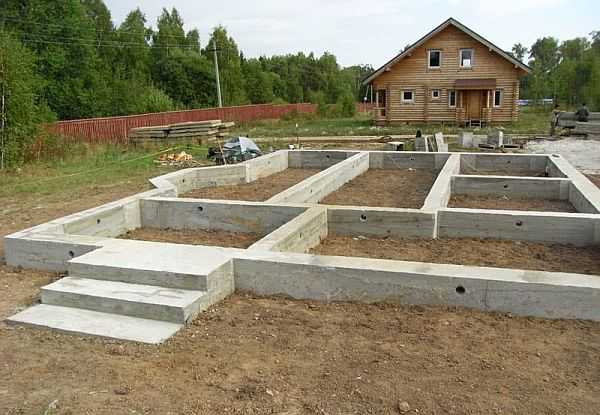
This article describes a method for calculating the parameters of a strip foundation (width) for the bearing capacity of soils
The content of the article
Calculation method
The strip foundation can be calculated in two ways: by the bearing capacity of the soils under the sole and by their deformation. The first way is simpler. We will consider it.
We know for sure that the foundation is built first. But it is designed last. Its task is to transfer the load from home. And we will know it only after we decide on the type of all building materials and their volumes. So before starting to calculate the foundation, you must:
- draw a plan of the entire building with all the walls;
- decide whether or not a basement is needed, and what depth it should be, if needed;
- know the height of the base and the material from which it will be made;
- determine the type and thickness of materials used for insulation, wind protection, waterproofing, decoration both inside and outside.
For all materials used during construction, you need to find their specific gravity. It is advisable to draw up a table: it will be easier to work. Only then can you start calculating.
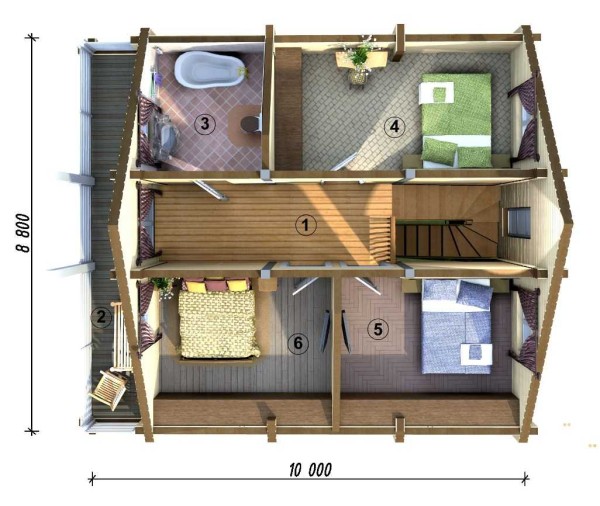
To calculate the strip foundation, you will need a project with a detailed indication of the materials used and their thickness
The strip foundation is most often made monolithic or precast concrete... Much less often today brick or rubble concrete tapes are made: they are less reliable, but at the same time, more material is required for their construction, although its cost may be less.
Conventionally, the calculation of the strip foundation can be divided into several stages:
- Determination of the load on the foundation.
- Choosing ribbon options.
- Adjustment depending on conditions.
Now about all the stages in more detail.
Collecting loads on the foundation
At this stage, the mass of all building materials that are used for construction is summed up:
- walls - external and internal (the total area is taken, not taking into account the cutouts on the doors and windows);
- floor slabs and materials for it;
- ceiling and ceiling slab;
- rafter system and roofing materials;
- stairs and other internal elements of the house;
- external heat and wind insulation and finishing;
- basement and foundation (for a start - roughly);
- fasteners (nails, screws, pins, etc.)
As already mentioned, by this moment a building plan with more or less accurate dimensions should already be ready. Calculation of the mass of the building materials used is simple: find the area on which it will be located, multiply by the specific gravity, you get the mass.
If the calculated element is rectangular, find its area by multiplying the length of the sides. If you count in meters, you get m2... Multiplying by the thickness of the material in the same units (in meters), you get the volume in cubic meters - m3... It will be more convenient to work this way: most of the specific gravity of building materials is given in kilograms per cubic meter (kg / m3). By multiplying the found volume with the specific gravity of the material, you get the mass of the material for this plane.
Example of calculating the mass of a wall
To make it clearer, let's give an example. Let's calculate how much the wall will weigh from a profiled pine bar 150 * 150 mm, with linden lining sheathing with a thickness of 14 mm, a lathing from a pine bar 50 * 20 mm. The wall is 4 m long and 2.8 m high.
The specific weight of the purchased pine timber (may be different) 570 kg / m3, lining 530 kg / m3, bar 510 kg / m3.
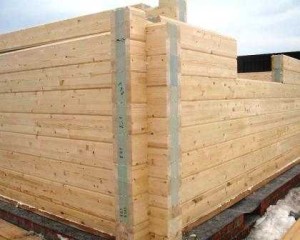
Example of calculating wall load
Wall area: 4m * 2.8m = 11.2m2.
The volume of the timber in the wall will be 11.2 m2 * 0.15 m (timber thickness) = 1.68 m3.
Multiplying the volume by the specific weight of the timber, we get the mass of the wall: 1.68 m3 * 570 kg / m3 = 957.6 kg.
Now we find the volume of the lining on the wall: 11.2 m2 * 0.014 m (lining thickness) = 0.16 m3.
We find out how much the lining weighs by multiplying its specific gravity by volume: 0.16 m3 * 530 kg / m3 = 84.6 kg.
The number of lathing is considered differently: we determine how many planks are nailed. We will nail the crate lengthwise with a step of 60 cm. We will get 5 strips 4 m long. There will be 20 running meters in total. Now we find the volume: 20 m. * 0.05 m * 0.02 m = 0.02 m3.
Now we find the mass of the crate: 0.02 m3 * 510 kg / m3 = 10.2 kg.
Now we find a lot of all materials for the wall: 957.6 kg + 84.6 kg + 10.2 kg = 1052.4 kg.
We think the principle is clear. But counting every wall like that is long. Then you can make it easier: determine how much one square meter of the wall weighs, then find the area of all walls that have the same finish and get their total mass.
We calculated that the mass of a wall with an area of 11.2 m2 will be 1052.4 kg. It turns out that one square weighs 1052.4 kg / 11.2 m2 = 93.96 kg / m2... Now, having calculated the area of all walls with such a finish, we can find their total mass. Let their total area be 42 m2... Then they will weigh 42 m2 * 93.96 kg / m2 = 3946.32 kg.
Using this technique, find the mass of all the listed elements. If they have complex geometry, break them down into simple shapes and so determine the area. There shouldn't be any problems with the rest.
House payload
In addition to building materials, the whole situation in the house will press on the foundation: furniture, appliances, people, etc. It is very long to count all this, so when planning it is assumed that one square meter of area has a payload of 180 kg / m2... To find out the total payload of a house, multiply its area (of all floors) by this figure.
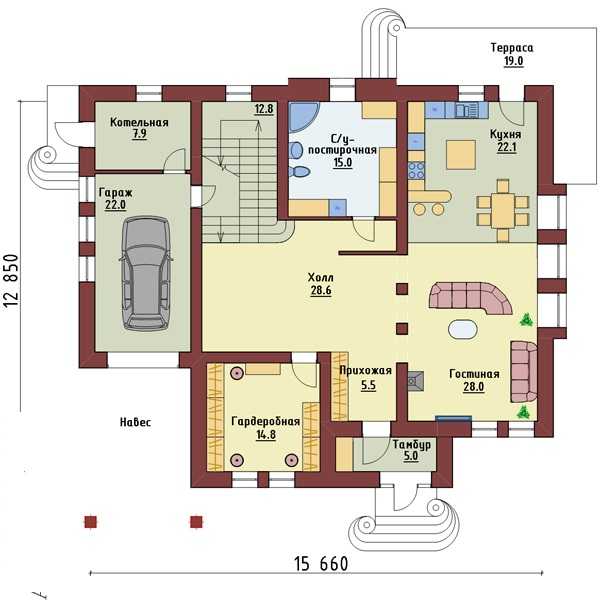
It is necessary to add the load from all interior items, equipment, etc. to the total load from the house.
Snow load
In most regions, it is also necessary to take into account the load on the foundation from snow. Snow loads are determined by region (see photo), their values are given in the table.
But since the roofs are different, and they accumulate different amounts of snow. Therefore, depending on the angle of the slope, the coefficients are applied:
- the angle of inclination is less than or equal to 25 ° - the coefficient is 1 (the snow load is taken from the table without changes);
- the tilt angle is greater than or equal to 60 ° - the coefficient is 0 - the snow load is not taken into account.
In all other cases (the angle of inclination of the roof is from 25 ° to 60 °), the values are selected from 0 to 1 (a graph is built and the coefficient is determined from it).
How to calculate the snow load on the roof? You have sewn your region, you know the average load per square of the roof, determined the coefficient. Now you need to multiply the total roof area by all these numbers.
Example: let the snow load in the region 180 kg / m2, total roof area 65 m2, the coefficient of accounting for the angle of the roof slope is 0.82 (the angle of inclination is about 30 °). Find the snow load: 65 m2 * 180 kg / m2 * 0.82 = 9594 kg.
This load will need to be added to the mass of the house and its payload.
Calculation of the strip foundation: determine the width of the sole
When calculating the strip foundation, it will be necessary to determine its two parameters:
- laying depth + base / plinth height = height;
- tape width;
The third - the length - is known. This is the sum of the lengths of all the walls, under which the foundation will be laid.
The depth of the laying is largely determined depending on the type of soils under the sole. General recommendations can be found in the table, and for a description of determining the depth of laying, read the article “How deep should the foundation be?.

Table with the recommended depth of the foundation, depending on the type of soil and the level of groundwater (to enlarge the picture, right-click on it)
Let us assume that the depth of the foundation for our conditions is below the freezing level of the soil, the height of the base is 20 cm.The soil freezes in our region by 1.4 m. According to the recommendations, the foundation should be 15 cm below the freezing level. We get the total height: 1.4 m + 0.2 m + 0.15 m = 1.75 m.
Now you need to calculate the width of the strip foundation. It depends on the distance at which the walls are located and the material from which we will build it. The recommended values are shown in the table.
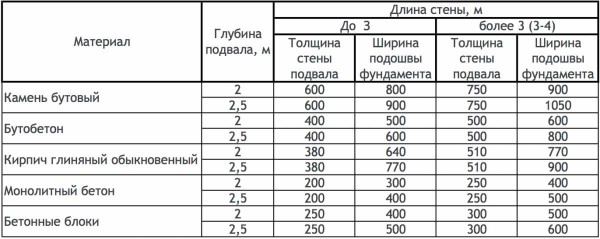
Choose the width of the foundation depending on the material and the distance between the walls (to increase the size of the picture, right-click on it)
Calculation of the load on the foundation
Now you need to find the force with which the house will press on the foundation. For this, the total mass of the house (the mass of all elements + payload + snow) is divided by the area of the foundation.
We find the area of the strip foundation by multiplying its length by the width selected in the previous paragraph. Then we divide the total load from the house by the area of the foundation in square centimeters. We get the specific load for each square centimeter of the strip foundation.
Example. Let the load from the house be 408,000 kg, the area of the strip foundation (length 4400 cm, width 30 cm) - 132,000 cm2... Dividing these values, we get: 3.09 kg presses for each centimeter.
Now it is necessary to find out whether the soils under the base of the foundation will withstand this value. Any soil is able to withstand some pressure. These values have been calculated and entered into the table. We find the type of soil under the base of the foundation (determined by geological research) and look at its specific bearing capacity.
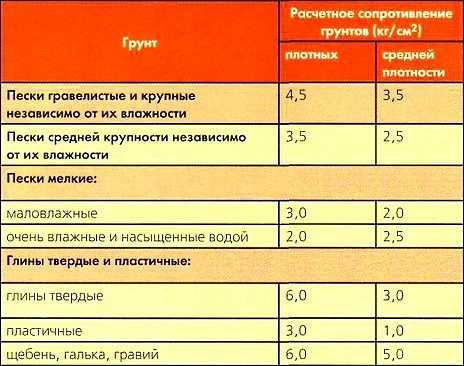
Bearing capacity of soils - we compare the found load from the house with the standard for your soil
If the bearing capacity of the soil is greater than the load from the house, everything is chosen correctly. If not, adjustments need to be made.
Adjusting parameters
If the load transmitted through the strip foundation is large for these soils, there are two ways out: use lighter materials during construction or increase the width of the strip.
Changing the material is very laborious: often changing one material leads to a chain of changes in the parameters of a number of others. As a result, the calculation of the mass has to be redone. Therefore, more often increase the thickness of the tape in the foundation. This increases the specific load. But a too wide strip foundation (wider than 60 cm), especially a deep one, is economically unprofitable: a large consumption of material and labor costs. In this case, it is necessary to compare the cost of several types of foundation.

The width of the monolithic strip foundation is selected based on the calculated load from the house and the bearing capacity of the soil
Do not forget to recalculate its weight after changing the width of the tape and adjust the weight of the building accordingly.
Read about the calculation of reinforcement for a strip foundation here.
How to calculate the cubic capacity of the foundation
It is better to take into account the mass of the foundation when calculating its volume: this figure will be useful to you when pouring the foundation: you will know how much concrete to order or how many materials will need to be purchased.
All initial data are already known: height, width and length of the tape. Multiply them, you get the cubic capacity of the foundation.
For example, let's calculate the volume of the foundation for the previously calculated tape: 44 m long, 30 cm wide (0.3 m), 1.75 m high.Multiply: 44 m * 0.3 m * 1.75 m = 23.1 m3... In fact, the consumption is likely to be slightly higher: about 25 cubic meters. You should be guided by this figure when ordering concrete.
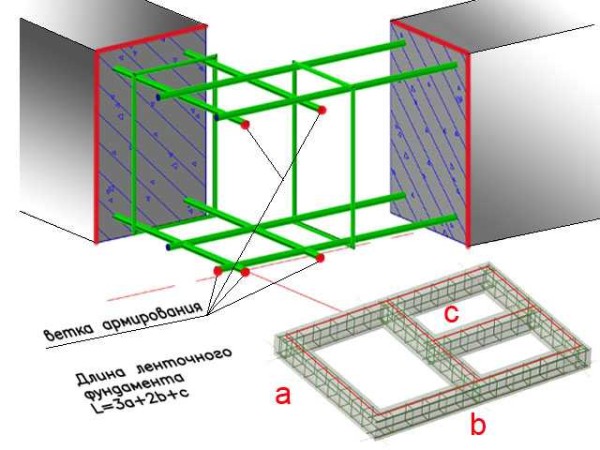
The cubic capacity of the foundation is calculated based on the found (assumed) dimensions of the tape: length, height and width by multiplying them

